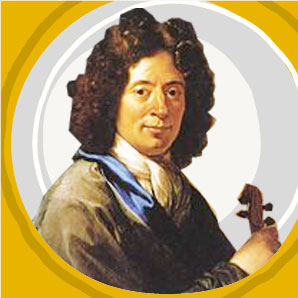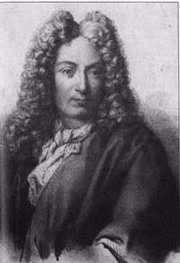A. Corelli - Biography
A. Corelli Biography
Arcangelo Corelli (February 17, 1653 – January 8, 1713) was an Italian violin player and Baroque music composer.
He was born at Fusignano, in the current-day province of Ravenna, and little is known about his life. His master on the violin was Bassani. Matteo Simonelli, the well-known singer of the pope’s chapel, taught him composition.
His first major success was gained in Paris at the age of nineteen, and to this he owed his European reputation. From Paris, Corelli went to Germany. In 1681 he was in the service of the electoral prince of Bavaria; between 1680 and 1685 he spent a considerable time in the house of his friend Cristiano Farinelli. In 1685 he was in Rome, where he led the festival performances of music for Queen Christina of Sweden and he was also a favorite of Cardinal Pietro Ottoboni (who in 1689 became Pope Alexander VIII). From 1689 to 1690 he was in Modena; the Duke of Modena was generous to him. In 1708 he returned to Rome, living in the palace of Cardinal Ottoboni. His visit to Naples, at the invitation of the king, took place in the same year.
The style of execution introduced by Corelli and preserved by his pupils, such as Francesco Geminiani, Locatelli, and many others, has been of vital importance for the development of violin-playing, but he used only a limited portion of his instrument's capabilities. This may be seen from his writings; the parts for violin never proceed above D on the highest string, the highest note in the third position; it is said that he refused to play, as impossible, a passage which extended to A in altissimo in the overture to Handel’s oratorio Trionfo del Tempo (premiered in Rome, 1708), and took serious offence when the composer played the note in evidence of its practicability.
Nevertheless, his compositions for the instrument mark an epoch in the history of chamber music; his influence was not confined to his own country. Even Johann Sebastian Bach is said to have deferred to him. Musical society in Rome owed much to Corelli. He was received in the highest circles of the aristocracy, and arranged and for a long time presided at the celebrated Monday concerts in the palace of Cardinal Ottoboni.
Corelli died in possession of a fortune of 120,000 marks and a valuable collection of pictures, the only luxury in which he had indulged. He left both to his benefactor and friend, who generously made over the money to Corelli's relations. Corelli is buried in the Pantheon at Rome.
His compositions are distinguished by a beautiful flow of melody and by a mannerly treatment of the accompanying parts, which he is justly said to have liberated from the strict rules of counterpoint.
Six collections of concerti, sonatas and minor pieces for violin, with accompaniment of other instruments, besides several concerted pieces for strings, are authentically ascribed to Corelli. The most important of these is the XII Suonati a violino e violone o cimbalo (Rome, 1700). Corelli also wrote Concerto Grosso Op. 6, a portion of which (Adagio) is a part of the soundtrack of the recent film Master and Commander: Far Side of the World.
This biography is published under the GNU Licence

